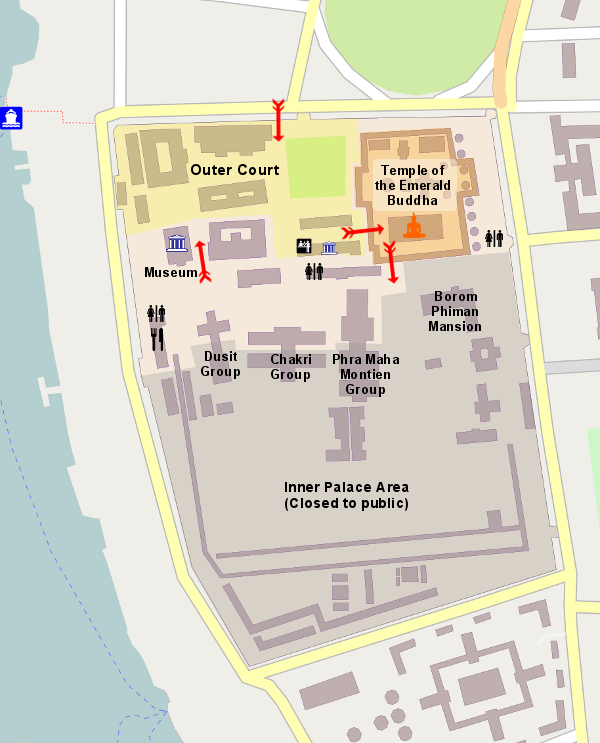King of Thailand
Bhumibol Adulyadej (Thai: ภูมิพลอดุลยเดช; RTGS: Phumiphon Adunyadet; pronounced [pʰūː.mí.pʰōn ʔà.dūn.já.dèːt] ( listen); see full title below; born 5 December 1927) is the King of Thailand. He is also known as Rama IX, as he is the ninth monarch of the Chakri Dynasty. Having reigned since 9 June 1946, he is the world's longest-serving current head of state and the longest-reigning monarch in Thai history, serving for 68 years, 200 days.
listen); see full title below; born 5 December 1927) is the King of Thailand. He is also known as Rama IX, as he is the ninth monarch of the Chakri Dynasty. Having reigned since 9 June 1946, he is the world's longest-serving current head of state and the longest-reigning monarch in Thai history, serving for 68 years, 200 days.
Bhumibol was crowned King of Thailand on 5 May 1950 at the Royal Palace in Bangkok where he pledged that he would "reign with righteousness for the benefit and happiness of the Siamese people" ("เราจะครองแผ่นดินโดยธรรม เพื่อประโยชน์สุขแห่งมหาชนชาวสยาม"). Notable elements associated with the coronation included the Bahadrabith Throne beneath the Great White Umbrella of State; and he was presented with the royal regalia and utensils.
In 1950 on Coronation Day, Bhumibol's consort was made Queen (Somdej Phra Boromarajini). The date of his coronation is celebrated each 5 May in Thailand as Coronation Day, a public holiday. On 9 June 2006, Bhumibol celebrated his 60th anniversary as the King of Thailand, becoming the longest reigning monarch in Thai history.
Following the death of his grandmother Queen Savang Vadhana, Bhumibol entered a 15-day monkhood (22 October 1956 – 5 November 1956) at Wat Bowonniwet, as is customary for Buddhist males on the death of elder relatives.[33] During this time, Sirikit was appointed his regent. She was later appointed Queen Regent (Somdej Phra Boromarajininat) in recognition of this.
Although Bhumibol is sometimes referred to as King Rama IX in English, Thais refer to him as Nai Luang or Phra Chao Yu Hua (ในหลวง or พระเจ้าอยู่หัว: both mean "the King" or "Lord Upon our Heads"). He is also called Chao Chiwit ("Lord of Life"). Formally, he would be referred to as Phrabat Somdet Phra Chao Yu Hua (พระบาทสมเด็จพระเจ้าอยู่หัว) or, in legal documents, Phrabat Somdet Phra Paraminthara Maha Bhumibol Adulyadej (พระบาทสมเด็จพระปรมินทรมหาภูมิพลอดุลยเดช), and in English as His Majesty King Bhumibol Adulyadej. He signs his name as ภูมิพลอดุลยเดช ป.ร. (Bhumibol Adulyadej Por Ror; this is the Thai equivalent of Bhumibol Adulyadej R[ex]).
Grand Palace
On Saturday 27 Dec 2014 Elder and Sister Moleff and Elder and Sister Ure took a taxi to the Grand Palace.
The Grand Palace (Thai: พระบรมมหาราชวัง, RTGS: Phra Borom Maha Ratcha Wang) is a complex of buildings at the heart of Bangkok, Thailand. The palace has been the official residence of the Kings of Siam (and later Thailand) since 1782. The king, his court and his royal government were based on the grounds of the palace until 1925. The present monarch, King Bhumibol Adulyadej (Rama IX), currently resides at Chitralada Palace, but the Grand Palace is still used for official events. Several royal ceremonies and state functions are held within the walls of the palace every year. The palace is one of the most popular tourist attractions in Thailand.

The Temple of the Emerald Buddha
Wat Phra Si Rattanasasadaram, generally called the Temple of the Emerald Buddha in English or Wat Phra Gaeo in Thai, is a temple purpose-built to house a Buddha image carved from a large solid piece of green jadite. Chaophraya Chakri, who went on to become King Rama I, brought the image from Vientiane when he captured the city in 1778. King Rama I built the temple and enshrined the Emerald Buddha there as a symbol of Siam's regained nationhood. The temple does not house any monks. Rather, it is more like the personal chapel of the royal family.
 |
| This is us within the Grand Palace walls. Elder and Sister Moleff and Ssiter and Elder Ure |
 |
| There were several murals painted on long walls that tell stories |
 |
| This is the story of the War in Heaven. The fight over good and evil. You can see the evil figure in black on the left |
All that you see below was done by hand, piece-by-piece. The beauty is stunning.
 |
| This, of course, is a Model of Angkor Wat |
 |
| The craftsmanship and color is a sight to see. |
 |
| This is where the Emerald Buddha resides. Because of the sanctity of the place, we were not allowed to take pictures inside the building. |
 |
| Elder Moleff in good company. |
 |
| Took a little rest. Elder Moleff, Elder Ure and Sister Ure |
 |
| Our yard back home should look so good. |
 |
Chakri Maha Prasat
The modern central court is dominated by the Chakri Maha Prasat hall. The hall was built by King Rama V and completed in 1882. Its unusual design is due to some controversy during its construction. The original architect was a Briton working in Singapore named John Clunich. Rama V wanted an entirely western look to his new home, but others in the court argued that the king's residence and throne hall should reflect Siamese motifs. Thus the domed roof was replaced by a Thai styled roof. |


























No comments:
Post a Comment